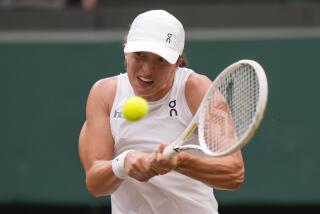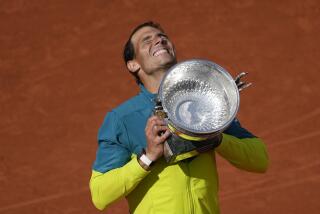Nadal at No. 2 simply doesn’t compute
WIMBLEDON, England -- Computers, both the lifeblood and the bane of human existence, have begun lying again.
These lying computers would not be the same lying computers who had their little sniveling get-together in 2003 to keep USC out of the Sugar Bowl, but they’re surely distant cousins of those other lying computers.
These would be the tennis rankings computers, and while they basically do an upstanding job keeping track of all the Russians and Serbs and Russians and Spaniards and Russians on the men’s and women’s lists, they’ve frozen their cursors and lost their minds at the top of both.
This nascent week, they continue to have Roger Federer at No. 1 in the world for a 232nd consecutive week and Rafael Nadal at No. 2 for a 155th consecutive week. That’s their 12-month judgment and all -- and they’re soooo judgmental as they think they’re always right -- but this Wimbledon dispensed a tectonic shift.
Men’s tennis pivoted this momentous Wimbledon, as the top player in the world for the most recent eternity, Federer, yielded to the top player in the world at the moment, Nadal.
He yielded ever so narrowly, by a few points here and a few shots there, by 9-7 in the fifth set in one of the most riveting and doubly ennobling matches anybody ever saw, but he yielded. His elegantly despotic five-year reign at Wimbledon had remained one of his most secure compounds, free from the hounds forever yapping meekly upward at him, until the one from Spain with the biceps and the backhand worthy of an aria got through.
With those walls penetrated, Federer is the second-most prominent player in the world, and what a strange sound that carries, seeing as how he’s been ensconced as a joy-to-watch No. 1 for so long it seems he’s built a mansion there.
So elongated had been his Wimbledon reign that it looked positively surreal seeing him walk around in the dark Sunday night, in his white cardigan with the “RF” logo, with that plate they give to the thanks-for-coming guy in the Wimbledon final.
It felt befuddling just seeing him at the interview dais, unable to conceal a crestfallen state that seemed to leak out into view through his pores. “Probably my hardest loss, by far,” he said, thereby using the word “loss” -- at Wimbledon! -- after all this time.
His countenance bore the unmistakable suggestion of -- dare we say -- No. 2. Just to observe it made the computers seem daft, even as they arrogantly assume they’re so fail safe.
They try to tell us No. 2 would be the guy who just showed the uncanny versatility to win the French Open and Wimbledon in the same June-July, the first time that’s been done since the North Star of fortitude, Bjorn Borg, won both in 1980.
No. 2 would be the one who beat No. 1 by 6-1, 6-3, 6-0, on Paris clay, then came to Federer’s domain and wound up lying on the grass behind the baseline in a very uncommon state of mirth? If that’s No. 2 after these last four Sundays, then let’s just say somebody’s loopy in the hard drive.
Nadal agrees with them, of course, but that’s a nice young man’s humility for you. The same humility -- a chronic assumption he might lose any time -- feeds his unquenchable will, which feeds his infuriating defense that generally makes people hit one more shot and makes them, as the analyst Luke Jensen put it, “want to go in the locker room and just want him to go away.” The defense, on slower courts, helped him nibble year by year toward Federer -- four sets as a surprise finalist in 2006, five in 2007, paydirt in 2008.
So in a Wimbledon that reintroduced Marat Safin as an elite semifinalist, that introduced many to Zheng Jie’s fine moxie and marvelous backhand, that staged maybe the best men’s final since Borg versus McEnroe in 1980, changes came and computers lagged.
For just as this Wimbledon showed us they’ve got the wrong guy at No. 1, it showed us they’ve got the wrong idea at No. 1 in the women’s game. They should simply vacate No. 1 and start those rankings at No. 2.
At different stages of the tournament, No. 1 could have -- and did -- become available to four different women at the soft, all of whom refused either to snare or cement it until two people who know how to reside at the top, Venus and Serena Williams, came to define the Wimbledon women.
Still lodged at Nos. 6 and 7, they’re the leading stars in a hodgepodge heading into Flushing Meadow, and if one of them can win the U.S. Open, then that player would stand as the real No. 1, the one judged by eyeballs and not know-it-all machines that turn on and off much too slowly.
More to Read
Go beyond the scoreboard
Get the latest on L.A.'s teams in the daily Sports Report newsletter.
You may occasionally receive promotional content from the Los Angeles Times.










